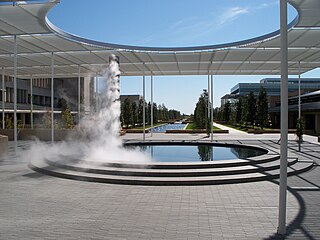The Stanford University School of Humanities and Sciences is the heart of the undergraduate program and grants the majority of Stanford University's degrees. The School has 27 departments and 20 interdisciplinary degree-granting programs. The School was officially created in 1948, from the merger of the Schools of Biological Sciences, Humanities, Physical Sciences, and Social Sciences. Those schools date from the mid-1920s when the university first organized individual departments into schools.

Hacettepe University is a leading state university in Ankara, Turkey. It was established on 8 July 1967. It is ranked first among the Turkish universities by URAP in 2021.

Chapman University is a private research university in Orange, California. Encompassing eleven colleges, the university is classified among "R2: Doctoral Universities – High research activity". The school maintains its founding affiliations with the Christian Church and the United Church of Christ, but is a secular university.

The Federal University of Juiz de Fora is a public research university in Brazil. Throughout its over 50 years of existence, the university has undergone significant growth, strengthening the quality of undergraduate and graduate education while maintaining its role as an agent of community development.

The College of Arts, Sciences, and Engineering is one of the primary units of the University of Rochester, encompassing the majority of the undergraduate and graduate enrollment. The College is divided in the units of Arts and Sciences and the Hajim School of Engineering and Applied Sciences. The College is located on the River Campus of the University of Rochester, though some departments maintain facilities on other campuses. The College was established in 1955 upon the merger of the separate colleges for men and women at the university.
The University of Virginia College of Arts & Sciences is the largest of the University of Virginia's ten schools. Consisting of both a graduate and an undergraduate program, the College comprises the liberal arts and humanities section of the University.
The University of British Columbia (UBC) is a Canadian public research university with campuses in Vancouver and Kelowna, British Columbia. The following is a list of faculties and schools at UBC.

The Iligan Institute of Technology, commonly referred to as, is a public coeducational institution of higher learning and research university located in Iligan City, Philippines, charted in 1968 by Republic Act 5363 and integrated as the first autonomous unit of the Mindanao State University System in 1975.
The Zanvyl Krieger School of Arts & Sciences is an academic division of the Johns Hopkins University, a private research university in Baltimore, Maryland. The school is located on the university's Homewood campus. It is the core of Johns Hopkins, offering comprehensive undergraduate education and graduate training in the humanities, natural sciences, and social sciences.
The Texas Tech University College of Arts & Sciences was founded in 1925 as one of Texas Tech University's four original colleges. With 16 departments, the college offers a wide variety of courses and programs in the humanities, social and behavioral sciences, mathematics and natural sciences. Students can choose from 41 bachelor's degree programs, 34 master's degrees and 14 doctoral programs. With over 10,000 students enrolled, the College of Arts & Sciences is the largest college on the Texas Tech University campus.
The University of Pennsylvania School of Arts and Sciences is the academic institution encompassing the humanities, social sciences, and natural sciences at the University of Pennsylvania.
Academics at the Massachusetts Institute of Technology are organized into 6 divisions containing 32 academic departments or faculties along with many interdisciplinary, affiliated, and intercollegiate research and degree programs. The Schools of Engineering, Science, Sloan School of Management, Humanities, Arts, and Social Sciences, Architecture and Urban Planning, and the Whitaker College of Health Sciences and Technology.
The College of Liberal Arts and Social Sciences (CLASS) is one of 14 academic colleges at the University of Houston. With nearly 10,000 students, CLASS is the largest college of the university, and was established in 2000 after the College of Humanities, Fine Arts, and Communication and the College of Social Sciences merged.

The Faculty of Arts is one of the largest faculties at The University of Melbourne. It is the university's home of teaching and research in the humanities, social sciences and languages. Teaching of the arts and humanities at The University of Melbourne began when the university was first opened to students in 1855, and the Faculty of Arts officially opened in 1903.

The University of Texas at Dallas is a public research university in the University of Texas System. The University of Texas at Dallas main campus is located in Richardson, Texas. The University of Texas at Dallas offers over 148 academic programs across its seven schools, including 57 baccalaureate programs, 59 masters programs and 32 doctoral programs, and hosts more than 40 research centers and institutes. The school also offers over 50 undergraduate and graduate certificates.
The College of Arts and Sciences (A&S) is the liberal arts and sciences unit of the University of Kentucky, located in Lexington, Kentucky. It is primarily divided between the natural sciences, social sciences, and humanities, and offers more than thirty degree options for both undergraduate and graduate students.

The Catholic University of Portugal, also referred to as Católica or UCP for short, is a concordat university headquartered in Lisbon and with four locations: Lisbon, Braga, Porto and Viseu. Besides the four centres in Portugal, UCP also has the University of Saint Joseph in Macau as its affiliate.
The College of Arts & Sciences of Ohio University is a college of Ohio University, a public research university in Athens, Ohio. It is one of its eleven colleges and is centrally located in Wilson Hall on the College Green. The college features twenty organized academic departments. Additionally, it hosts two centers for its International Studies and Law, Justice & Culture programs.
VNU University of Social Sciences and Humanities, or Hanoi University of Social Sciences and Humanities, is a major research university in Hanoi, Vietnam, and a member university of Vietnam National University, Hanoi.

NDHU College of Humanities and Social Sciences is an interdisciplinary school of Humanities and Social Sciences of National Dong Hwa University (NDHU). Founded in 1995, with Professor Yang Mu, the Founding Dean of HKUST School of Humanities and Social Science and Founding Director of Institute of Chinese Literature and Philosophy at Academia Sinica, as Founding Dean.








